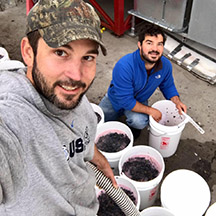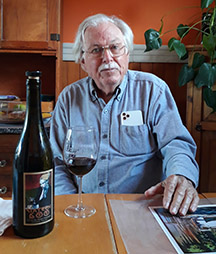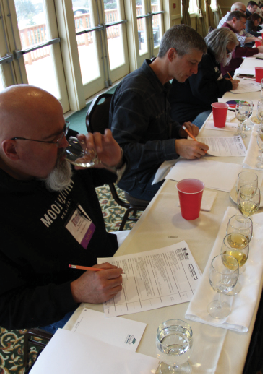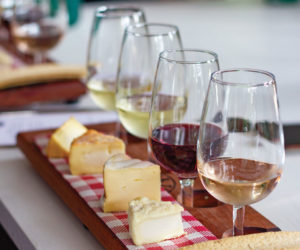Buckets of frozen must or juice allow winemaking season to be any time of the year. These juices are not concentrated and there is minimal intervention beyond flash freezing the grapes on the crush pad. Interested in exploring this option? Heed the advice from these three experts in the business.
Michael and Andrew Crews are the Owners of Wine Grapes Direct

Frozen grape buckets allow you to make the wine you want to make, when you want to make it. There is no appreciable difference between the resulting wines made from fresh grapes and those made from frozen must or juice. Several studies have shown a small increase in total phenolics from frozen grapes, but so far none have demonstrated a sensory impact.
The grapes are treated the same way they would be at a winery, except instead of starting fermentation they are put into buckets and flash frozen. Our reds have nothing added to them and only the stems are removed. The whites receive 75 parts per million SO2 at pressing. Our white juice pails contain 5.25 gallons (20 L) of settled juice and yield 5 gallons (19 L) of finished wine. Our red pails contain 5 gallons (19 L) of must and usually yield 3.5 gallons (13 L) of finished wine, but anywhere between 3–4 gallons (11–15 L) is normal depending on varietal and pressing.
Once they’re in the freezer, the pails are held below 0 °F (-18 °C) and the contents don’t change very much from that point — so they have a very long shelf life. After a few years there may be some visible oxidation on the surface, but so far no one has reported a pail “going bad” in the freezer.
Once received, the buckets should be thawed at 65–75 °F (18–24 °C). At this temperature it should take 1–2 days to completely thaw and reach a temperature suitable for fermentation. Thawing at colder temperatures will take longer, which gives wild microbes a better chance at corrupting the juice. Thawing or fermenting at warmer temperatures can risk cooking off some of the flavors. If you’re in a hurry, a warm water bath is the fastest way to effectively thaw a pail. There is no need to do a cold soak with previously frozen grapes. The freezing process ruptures some of the skin cell walls releasing more polyphenols into juice than cold soaking ever could! After quickly thawing the must or juice, pitch a cultured yeast rather than relying on native yeasts that will survive, but not thrive, the freezing process.
All of the buckets come with the listed Brix, pH, titratable acidity (TA), as well as other measurements and origin information. These measurements we post are an average taken from all the bins. There is usually some variation with the reds because the bins of grapes are individually fed into the destemmer and then flow directly into the buckets. So any bin-to-bin variation would also be reflected in the buckets. Usually the bins are all within +/-1 °Brix of the posted measurement. Also, as the reds soak on the skins some additional sugar and potassium can be released into the juice, causing the Brix and pH to rise. The numbers we post for the white juices are tank samples after all the grapes are blended together so the numbers are quite reliable. But it is always advisable to take your own measurements before making any adjustments.
The buckets the grapes come in are food-grade, however red wine ferments need 30% extra volume in the fermenter for the cap of skins to rise into, which means that a red ferment would overflow in the bucket! There is enough space to ferment whites, but be sure to transfer to a carboy before fermentation is complete to prevent oxidation.
Peter Brehm is the Owner of Brehm Vineyards

Making wine from frozen must or juice has many benefits, none more important than reliability and flexibility. You get grapes that are harvested at their prime for winemaking and have an idea about the chemical analysis of the grape ahead of time. Considerations of logistics for shipping to the ultimate winemaker are done with grapes or juice that is stable, not degraded or compromised in quality.
There are many other benefits too: You can make your wine on your schedule — no need to worry about missing harvest if you want to travel in the fall. It also allows the easy ability to make blends or co-ferment with different varietals, vintages, and vineyards. And you can make the same wine twice if you find out you loved the first batch when it was complete (assuming the juice is still in stock).
Most of these benefits listed so far have been for the convenience of the home winemaker. A benefit to the wine itself, though, is that there is a slight increase in color and yield from the freezing and thawing process. The freezing is basically a cold soak on steroids. Starting cold may be a lot easier than with fruit at 85 °F (29 °C). Frozen juice allows you many more options than fresh juice as well. The ice that forms and floats during the juice thawing is water. An undisturbed pail of thawed juice will be 6 °Brix on top and 40+ °Brix on the bottom. Potassium combined with the tartaric acid will create cream of tartar on the floor of the pail. These natural separations make accurate analysis of the juice or grapes initially difficult, however, it also allows for the production of ice wine or natural acid reduction. One juice — many possibilities.
Our red buckets are 6-gallons (23-L), filled with 5 gallons (19 L) of must and make 3–3.5 gallons (11–13 L) of wine. These grapes are gently destemmed and flash frozen. White grapes are whole bunch pressed at a low pressure in a pneumatic press. The white juice is chilled, settled, and racked off the gross lees into 6-gallon (23-L) buckets filled with 5 gallons (19 L) of juice.
As a grape grower and grape buyer we prefer vineyards with sustainable, regenerative practices. Certainly what happens in the vineyard goes all the way to your bottle of wine. The basic goal is to provide the winemaker with grapes as they were when harvested. We freeze them in time. The addition of sulfite is seldom used. If used, the addition is noted, and usually quite low. An exception would be grapes heavily infected with Botrytis. This juice will have sulfite and other additives if deemed appropriate. With time, frozen juices that are not sulfited will become dark in color and become oxidized. The freezing process reduces the juice’s fauna and the wine ferments without fear of spoilage. The yeast consume the oxygen and near the end of alcohol fermentation the oxidized color will fall out. There is no aroma impact, and the result is a wine more resistant to oxidation.
When you receive your grapes, take the lids off and inspect them for any freezer burned or moldy grapes. Remove any grapes that are questionable. As soon as possible submerge the skins in the juice at least once per day — if you leave undisturbed and mold forms, pick it out and discard. Keep it covered.
Under no circumstances should you let your grapes thaw slowly in a refrigerated environment. You want to thaw the grapes quickly and evenly. Room temperature, 70 °F (21 °C), is ideal for thawing. Start preparing your yeast early. While there are native yeast that survive the freeze, it is recommended that a strong yeast starter be added to the must or juice. Instead of a 103 °F (39 °C) rehydrated yeast and 80 °F (27 °C) must, you have a 40 °F (4 °C) must. Your goal is to have the temperature of your yeast starter and must within 10 °F (5 °C) of each other. Start your yeast while the grapes thaw. Gradually feed the watery, cold defrosted juice to the starter. As the yeast acclimates to a cold environment the must/juice warms to a temperature within 10 °F (5 °C) of the must/juice, submerge the skins, keep juice agitated. Do not cold shock the yeast.







